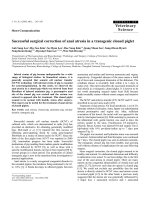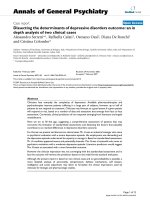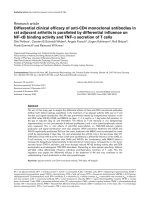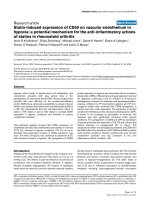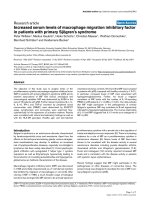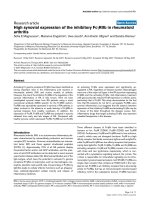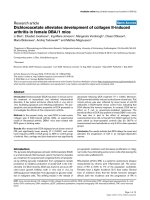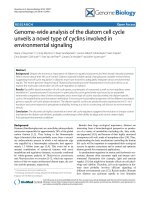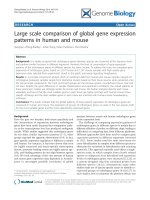Báo cáo y học: "Successful surgical resection of infected left atrial myxoma in a case complicated with disseminated intravascular coagulation and multiple cerebral infarctions: case report" ppt
Bạn đang xem bản rút gọn của tài liệu. Xem và tải ngay bản đầy đủ của tài liệu tại đây (769.43 KB, 4 trang )
CAS E REP O R T Open Access
Successful surgical resection of infected left atrial
myxoma in a case complicated with disseminated
intravascular coagulation and multiple cerebral
infarctions: case report
Daisuke Yoshioka, Toshiki Takahashi
*
, Toru Ishizaka and Takuya Higuchi
Abstract
Cardiac myxoma is the most common primary cardiac tumour, but infected cardiac myxoma is relatively rare.
Infected cardiac myxoma is very fragile, and has a potential to lead to catastrophic disorder with systemic
bacteremia, systemic mycotic embolism, and disseminated intravascular coagulation (DIC).
We present here the successful surgical treatment of a case of infected left atrial myxoma with septic shock, DIC
and cerebral infarction without he morrahage. Collective review of 58 reported cases with infected cardiac
myxoma revealed that surgical treatment for it were still challenging and its result was poor. Until date, only
one successful surgical treatment for a case complicated by DIC and cerebral infarctions has been reported, and
our report describes second such case of successful resection. Even though this report is limited to a case, only
aggressive and prompt surgical intervention could relieve the intractable c onditio ns in such a patient with
extremely high risk.
Background
Cardiacmyxomaisthemostcommonprimarycardiac
tumour, but infected cardiac myxoma is relatively rare.
To the best of our knowledge, 57 previous cases of
infected cardiac myxoma have been reported in the Eng-
lish literature [1-6]. Infected cardiac myxoma almost
always causes systemic bacteremi a, which easily leads to
septic shock, disseminated intravascular coagulation
(DIC), multiple organ failure. Infected cardiac myxoma
is also very fragile and often occurs with systemic embo-
lism including a cerebral infarction, and hence, surgical
resection of the tumor is mandatory for the relief of this
intractable condition. However, both DIC and cerebral
infarction have a high risk for the open heart surgery
with systemic heparinization. In this report, we describe
a case of infecte d left atrial myxoma with DIC and mul-
tiple cerebral infarctions, who underwent successful sur-
gical treatment.
Case Presentation
A 52-year-old man had fever and was diagnosed with an
influenza-B virus infection two weeks before admission
to our hospital. Despite receiving treatment for the
influenza virus, he d id not recover and his temperature
was elevated at 40°C. A blood culture was positive for
gram-positive coccus, and echocardiography showed a
large left atrial tumour, which was considered to be
atrial myxoma with mobile vegetation. He was referred
to our hospital for an emergent operation.
His physical examination revealed a temperature of
39.5°C and a blood pressure of 80/40 mmHg and a
heart rate of 120 beats/min. He had multiple embolic
lesions on the distal portion of his extremities. He was
delirious and a brain magnetic resonance imaging (MRI)
showed multiple small infarctions but fortunately no
haemorrhage was detected. Laboratory data revealed a
white blood cell count of 1 3000/mm
3
and a C-reactive
protein level of 30.0 mg/dl. His platelet count was only
1.0 × 10
4
/mm
3
and D-dimer was 12.72 μg/ml, which
indicated severe DIC. Echocardiography showed a large
mass (60 × 35 mm in diame ter) with a stem attached to
* Correspondence:
Department of Cardiovascular surgery, Osaka National Hospital, 2-14
Hoenzaka, Chuo-ku, Osaka city, Osaka, 540-0006, Japan
Yoshioka et al. Journal of Cardiothoracic Surgery 2011, 6:68
/>© 2011 Yoshioka et al; licensee BioMed Central Ltd. This is an Open Access article distributed under the terms of the Creative
Commons Attribution License ( g/licenses/by/2.0), which permits unrestricted use, distribution, and
reproduction in any medium, provi ded the original work is properly cited.
the septum of the atrial wall, which prolapsed into the
left ventricle during the diastolic phase with t rivial
mitral regurgitation (Figure 1).
An urgent operation was performed using tepid
hypothermic cardiopulmonary bypass (CPB) and the
usual dose of systemic heparinization. The tumor was
completely excised with the attached atrial septum via a
trans-septal approach. A small amount of vegetation
was observed in the posterior mitral chordae, which was
carefully excised without injuring the mitral structure.
The gross pathological findings were a very fragile myx-
oid tumor with the red thrombus (Figure 2A). The pla-
telet concentrate and fresh frozen plasma were
transfused after the end of CPB and complete hemosta-
sis was achieved.
After the operation, tumor and blood cultures were
positive for methicillin-sensitive Staphylococcus aureus.
He was still in septic septic shock soon after the opera-
tion, but after intravenous immunogloburin and intrave-
nous antibiotic therapy with ampicillin, his general
condition was getting better and was extubated at the
second postoperative day. The antibiotic therapy with
ampicillin was totally administered for six weeks. Histo-
logical examination showed that the mass was an
infected atrial myxoma, and gram stain ing of the
infected portion revealed the presence of gram-positive
coccal bacteria (Figure 2B).
Because of the low platelet count after the operation
and to prevent hemorrhagic complications, no a nticoa-
gulation therapy was performed in during the post-
operative course. But he suffered a brain haemorrhage
in the occipital lobe, but fortunately, recovered wit slight
cognitive decline (Figure 3). The patient was discharged
two months after the operation with a normal C-reac-
tive protein level and no fever was noted. Two years
later, he is asymptomatic with no clinical evidence of
recurrence.
Discussion
Although myxoma is the most common benign cardiac
tumour, infected cardiac myxoma is very rare. Only 57
English articles on infected cardiac myxoma have been
reported thus far in the literature.
The complication of embolism in patients with unin-
fected atrial myxoma is very common. However, once
infected, according to Bou gh et al., the incidence of
cerebral and systemic embolization from infected atrial
myxoma is much higher (88% of cases) than those
reported from uninfect ed myxoma (33% of cases) or
uncomplicated endocarditis (40% of cases) [7]. In our
review, cerebral complications including cerebral
infarction, haemorrhage and brain abscess were
reported in at least ten cases (16.4%) in the literature,
and a systemic embolism including cerebral infarction
were reported in at least 24 cases (39.3%). However,
actual embolic events may be much higher if brain and
systemic computed tomography (CT) scans or brain
MRI had been performed preoperatively in all cases.
Bacte rial cerebral infa rction is inclined to be a haemo r-
rhagic infarction, and once cerebral infarction is pre-
sented, the perioperativ e neurological risk is much
higher because cardiac surgery requires systemic
heparinization for cardiopulmonary bypass. In our
case, a post-operative cerebral haemorrhage was pre-
sented actually, although a pre-operative cerebral hae-
morrhage was not detected by brain MRI. Fortunately,
the patient recovered with slight cognitive decline.
However, if an obvious intracranial haemorrhage is
presented preoperatively, cardiac surgery must be post-
poned and salvage of the patient may be difficult. Col-
lective review of 58 cases with infected cardiac
myxoma demonstrated only one case with DIC and
cerebral infarction who successfu l underwent surgical
resection of infected myxoma [8].
Including our case, 47 of 58 cases (81.0%) were caused
by gram-positive cocci, and 14 of them were caused by
S. aureus. Five cases combined with DIC have been
reported, and all five cases were i nfected by S. aureus
[4,5,8,9]. DIC causes a haemostatic disorder and micro-
thromboembolisms in small systemic arteries, which
leads to multiple organ failure and creates a much
higher operative risk. Four of the five patients survived
but one died 10 days after surgery as a result of DIC [5].
Our case, which presented with both a bacterial cere-
bral infarction and DIC, is the second successful case
Figure 1 A large cardiac myxoma (60 × 35 mm in di ameter)
with a stem attached to the septum of the atrial wall, which
prolapsed into the left ventricle during the diastolic phase.
Yoshioka et al. Journal of Cardiothoracic Surgery 2011, 6:68
/>Page 2 of 4
reported. Even though this report is limited to a case,
only aggressive and prompt surgical intervention could
relieve the intractable conditions in such a patient with
extremely high risk.
Conclusion
In infected cardiac myxoma patients with severe compli-
cations, only aggressive and prompt surgical treatment
have to be performed for salvage of these patients.
Consent
The authors confirm that written consent has been
obtained from patient in order to publish photographs
and relevant clinical information included in the sub-
mitted manuscript.
Authors’ contributions
DY is responsible for acquisition of data and writing the original manuscript.
TT, TI and TH are responsible for conception and design as well as critical
revision of the manuscript. All authors approved the final version submitted.
Competing interests
The authors declare that they have no competing interests.
Received: 24 February 2011 Accepted: 12 May 2011
Published: 12 May 2011
References
1. Leone S, dell’aquila G, Giglio S, Magliocca M, Maio P, Nigro FS, Pacifico P,
De Chiara G, Acone N: Infected atrial myxoma: case report and literature
review. Infez Med 2007, 15:256-61.
2. Chan V, Veinot JP, Hynes M, Lapierre H, Ruel M: Infected right ventricular
myxoma and pulmonary valve endocarditis. J Thorac Cardiovasc Surg
2007, 134:248-9.
3. Falasca K, Ucciferri C, Mancino P, Di Girolamo A, Vecchiet J: Infected atrial
myxoma: a rare cause of fever. Infez Med 2008, 16:40-2.
4. Janion M, Sielski J, Ciuraszkiewicz K: Sepsis complicating giant cardiac
myxoma. Am J Emerg Med 2008, 26(387):e3-4.
5. Trimeche B, Bouraoui H, Garbaa R, Mahdhaoui A, Ben Rhomdane M, Ernez-
Hajri S, Jeridi G: Systemic embolism and septic shock complicated left
atrial myxoma: case report. Case Report Med 2009, 306375.
6. Guler N, Ozkara C, Kaya Y, Saglam E: Ruptured abdominal aortic aneurysm
after resection of an infected cardiac myxoma. Tex Heart Inst J 2007,
34:233-5.
7. Bough EW, Johnson EE, Zacks SI, Boden WE, Mandel A, Medeiros AA,
Korr KS, Shulman RS, Yashar JJ: Echocardiographic diagnosis of an
infected myxoma in an atypical location. Am Heart J 1987, 113:1031-2.
8. Veitch AM, Manghat NE, Kakani NK, Lewis CT, Ring NJ: Systemic septic
embolisation secondary to an atrial myxoma in a young woman. Emerg
Radiol 2006, 12:137-9.
Figure 3 Post-operative MRI showed a large cerebral
haemorrhagic infarction in the right occipital lobe.
Figure 2 (A): The gross pathological findings were a very fragile myxoid tumor (allow head) attached the septal wall (allow) with the
red thrombus and vegetation (*). (B): Hematoxylin and eosin (HE) and showed that the mass was an atrial myxoma, and gram staining of the
infected portion revealed the presence of gram-positive coccal bacteria.
Yoshioka et al. Journal of Cardiothoracic Surgery 2011, 6:68
/>Page 3 of 4
9. Riad MG, Parks JD, Murphy PB, Thangathurai D: Infected atrial myxoma
presenting with septic shock. J Cardiothorac Vasc Anesth 2005, 19:508-11.
doi:10.1186/1749-8090-6-68
Cite this article as: Yoshioka et al.: Successful surgical resection of
infected left atrial myxoma in a case complicated with disseminated
intravascular coagulation and multiple cerebral infarctions: case report.
Journal of Cardiothoracic Surgery 2011 6:68.
Submit your next manuscript to BioMed Central
and take full advantage of:
• Convenient online submission
• Thorough peer review
• No space constraints or color figure charges
• Immediate publication on acceptance
• Inclusion in PubMed, CAS, Scopus and Google Scholar
• Research which is freely available for redistribution
Submit your manuscript at
www.biomedcentral.com/submit
Yoshioka et al. Journal of Cardiothoracic Surgery 2011, 6:68
/>Page 4 of 4
